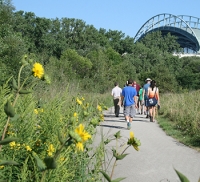The ecologist, hearing a gasp, searches for the source of the excitement. Looking up, she sees a tree with purple berries, filled with dining birds. She is saddened. The tree is a buckthorn – an invasive species that has taken over where native service berries used to grow. She is aware that the berries are not only devoid of important nutrients, but also cause dehydration in birds. This scene is one of heartache for her. She might come to volunteer and help create a healthier habitat.
These two friends are in the same place at the same time, and yet their experiences are very different. Both learned something by listening and looking at the very same scene, and yet they are coming to very different conclusions based not on their observations in the moment, but rather on past experiences.
Each conclusion is tied to the learning process we all go through: we make observations, add meaning, form beliefs, and take actions based on those beliefs. And each time we do this, our thinking is reinforced.
In this example, the ornithologist looks right past the berries. In her experience, a good birding practice is to look for specific patterns, shapes and colors on birds, so that they can be identified. By identifying the different kinds of birds, she can give them a name (which adds meaning), determine if this is a good place to look for birds (form a belief), then decide if she wants to come back (take an action).
It happens fast – in a split second. We don’t think much about the thinking process. And, yet, if we can get into the practice of unfolding how we add meaning or form beliefs, we can create deeper understandings of each other and our world.
The practice of exploring our learning process is simple. But it is often forgotten.
In this example, two people are forming opinions about the value of a specific moment. Imagine applying this practice in deciding, as parents, how to raise your children. Or in understanding how a policy decision is being made at work, or understanding what is happening in an election.
The practice I just described is supported by a visual tool called the “ladder of inference” and is one of many tools that can be used to uncover – and shift – our own thinking.
The “ladder of inference” is just one of the Systems Thinking tools the Urban Ecology Center uses in our planning, decision making and in working with students. It helps us build a deeper, shared understanding upon which we can then act.
Want to learn more? Please consider attending the next regional Systems Thinking Institute — happening right here in Milwaukee on March 29-31! Visit watersfoundation.org for details.





